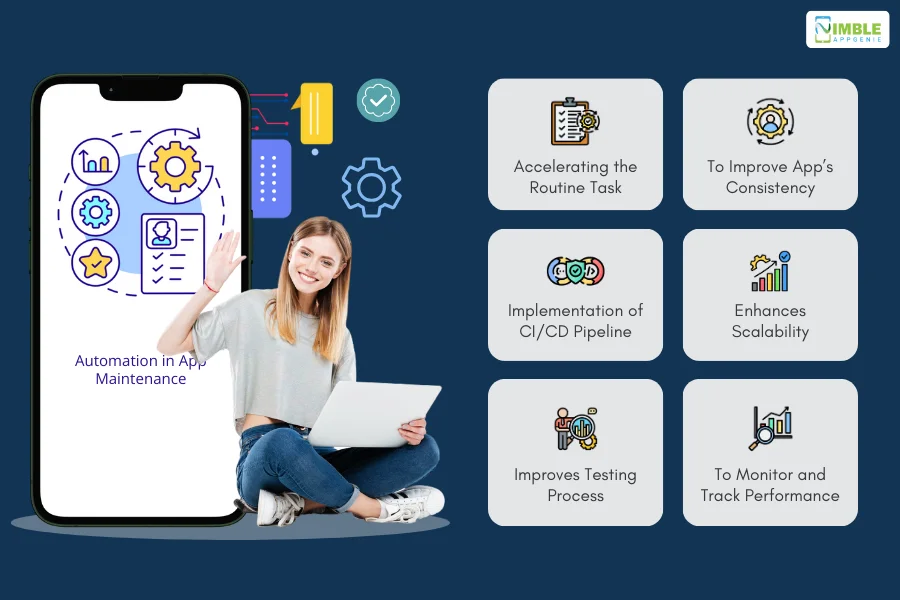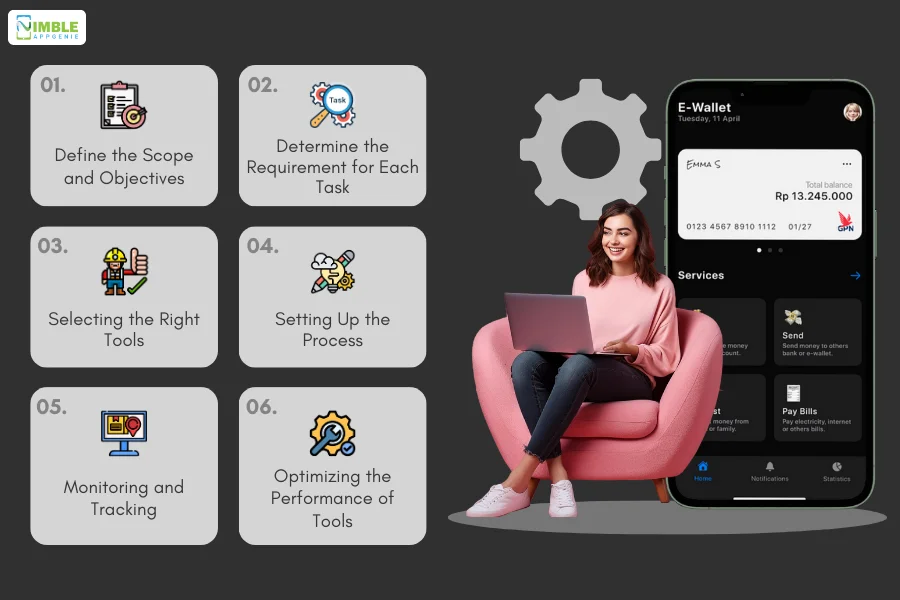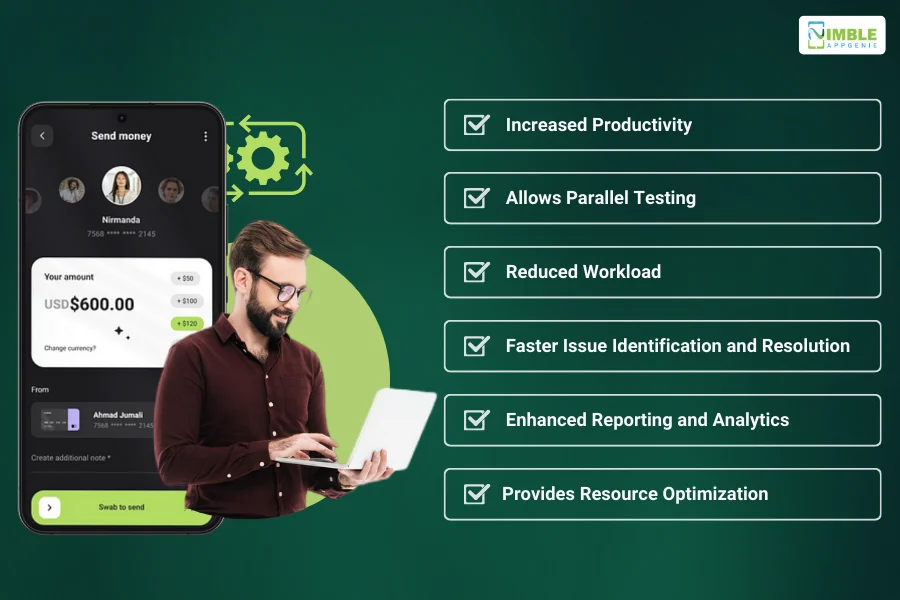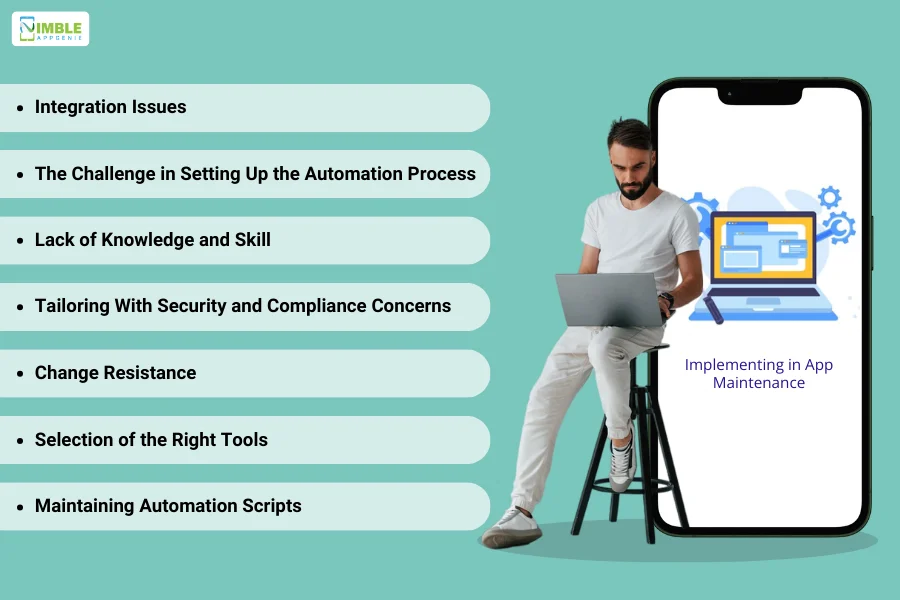In the era of adopting advanced technologies, it is vital to know how they can work in your case.
We understand that app maintenance can be a stressful exercise but with the right tools and automation practices, you can simplify it successfully.
Now, the question is how to implement automation during app maintenance.
Well, the right guidance over the automation concept, its role, procedure, advantages, and challenges can help you here.
Let’s begin to understand automation in app maintenance.
Concept of Automation in App Maintenance
What is automation in app maintenance?
Prior to understanding the process of implementing app maintenance automation, you should be aware of the concept.
Automation is a state of using the latest technological networks, programs, robotics, and processes for achieving the maximum output with minimal human input.
It is the use of tools, processes, and scripts is useful for streamlining and optimizing the repetitive tasks that are involved in the app maintenance process.
But what can be the exact functions of automation in app maintenance?
Let’s learn it all through the next section.
Role of Automation in App Maintenance
In the world of fast and quick solutions, people desire to have an app that can fulfill their needs in no time. To implement such speed and accuracy in the app, its maintenance plays a crucial role.
It is vital to make your app function based on the current market dynamics, guided by mobile app market research. And that’s where the importance of app maintenance comes into the picture.

When it comes to automation, knowing how it works and what it does to your app is important. Let’s find out the role of automation in app maintenance.
1. Accelerating the Routine Task
Routine tasks such as bug fixes, performance optimization, and all the other regular and systematic tasks that should be performed to ensure that the app remains up-to-date are critical here.
Implementation of automation in routine tasks is useful for reducing the time taken to perform regular app maintenance activities.
2. To Improve App’s Consistency
Consistency can be defined as keeping things looking and working within the same parameters throughout the app so that it doesn’t interrupt the user experience.
Automation plays an important role in improving the app’s consistency by following the predefined steps around different environments and instances.
3. Implementation of CI/CD Pipeline
Within the world of software, a CI/CD pipeline can be defined as an automation that enables incremental code changes from the developer’s desktops that are to be delivered reliably and quickly.
Automation is an integrated process that enhances continuous integration and continuous deployment, which enables frequent and reliable code updates.
4. Enhances Scalability
A scalable feature ensures that the traffic is managed and the app still performs effectively. Scalability within the application helps to handle increased loads gracefully while maintaining fast performance.
It ensures to scale up the app after managing increased volumes of data and complexity without any additional manual effort.
5. Improves Testing Process
Without mobile app testing, the chances of failure increase. The manual testing process can be tedious for devices, platforms, and scenarios.
Here, mobile app maintenance automation can help in conducting unit, integration, security, and performance tests for identifying and fixing errors.
6. Monitor and Track Performance
One of the most important roles of app maintenance is to monitor and track the complete performance of the app. With automation, monitoring, and tracking, app performance can be simplified using tools.
Implementing automation within the app can assist in understanding users’ needs and thereafter changing the app’s performance accordingly.
These are some of the roles you can find after implementing automation within the app maintenance practices. Now, let’s move on to how to automate app maintenance.
How to Implement Automation in App Maintenance?
Now, as you are aware of the concept and its role. The right app maintenance process can help you here.

Let’s come to understand the implementation process of automation in app maintenance.
Step 1- Define the Scope and Objectives
One of the prime steps is to know the aim, scope, and objectives for conducting app maintenance. This will clear out the path that needs to be followed for adopting automation in app maintenance. You should define the scope related to the tasks that need to be automated.
Step 2- Determine the Requirement for Each Task
You should know the tasks briefly and their related requirements. Identifying the operations of each task can help you decide where it’s needed to implement automation. Here you can create a detailed list of the tasks and activities that should be performed under every sector of app maintenance.
Step 3- Selecting the Right Tools
The next step is to select the right tools to implement automation within the tasks. The right tool can simplify and enable you to make the app maintenance process efficient. Various tools that you can select from are Appium, Robotium, Espresso, and others. You should select them as per the app’s size and features.
Step 4- Setting Up the Process
Now, it’s time to set up the selected tools for automation based on the app’s database and frameworks. Here you can make use of CI CD. There are multiple tools you can use for this process, including Jenkins, GitLab CI, and others.
Step 5- Monitoring and Tracking
Under this step, you have to track and test the implementation process of your app maintenance automation. If you find errors in monitoring and testing, then the tools that you implemented for automation should be verified thoroughly.
Step 6- Optimizing the Performance of Tools
Implementation of automated tools for app maintenance requires optimization and a continuous check so that optimum and desired results can be derived. To check and maximize the tool’s performance, it is required to know its functionality successfully.
This series of steps provides a path to be adopted for enabling mobile app maintenance automation.
Now, the question that arises is how automation can enable and strengthen your app maintenance process and what kind of benefits it can provide to your app.
Let’s know them all in the next section.
Advantages of Conducting Automation in App Maintenance
What are the app maintenance automation benefits?

Here is a list of certain key advantages, your app can get from automating app maintenance tasks.
A) Increased Productivity
An automated process is designed for app performance optimization. Thus, it enhances the productivity of the app and contributes to reducing the burden on the quality checkers and designers. It also reduces the time and cost of app maintenance.
B) Allows Parallel Testing
Have you thought of testing the app in parallel with maintaining it? This can assist in reducing app maintenance downtime in the long run. With the use of automation, testing can be performed within multiple environments simultaneously.
C) Reduced Workload
Several routine check-ups and maintenance tasks can be done by including automation within the app maintenance process. It gives relief to employees to focus on other tasks, as it can automatically simplify app maintenance activities.
D) Faster Issue Identification and Resolution
One of the key benefits of implementing automation in app maintenance is detecting issues before they occur. This process is effective in risk mitigation. Through automation, real-time monitoring, and prompt alerts, issues can be processed to reduce mobile app downtime.
E) Enhanced Reporting and Analytics
Automated app maintenance processes that include fewer human interactions also reduce the risk of failure.
Here, tasks, processes, and workflow are designed based on quality metrics with a standardized operating system that helps to improve reporting and analysis time during app maintenance.
F) Provides Resource Optimization
Resource optimization is an important part of app maintenance. Automation can also be adopted for resource allocation and planning, which will be useful for reducing human errors while performing app maintenance activities.
These are some of the benefits that can be achieved by adopting automation practices in app maintenance.
Till now, we have discussed all the importance, role, and process, which means you all have a blueprint for adopting automation in app maintenance, right?
However, there are certain challenges to look out for within the guide to app maintenance automation.
Challenges Faced While Implementing App Maintenance Automation
Process, role, and benefits, do you think these will all be sufficient to head on with the mobile app maintenance automation?

Well, there is a bit more you should know. Let’s learn about the challenges of automation in app maintenance together.
-
Integration Issues
While performing the task of automation, you can face an issue of integration with the existing systems and infrastructure.
This can be a challenging task because older systems and processes might not support automation tools, which require additional effort to upgrade.
-
The Challenge in Setting Up the Automation Process
As already discussed above, setting up the automation process can be a big headache. It is a time-consuming and complex process. You might require an appropriate customization plan for tailoring automation scripts and tools.
-
Lack of Knowledge and Skill
Implementing automation within the app maintenance process requires advanced skills and training. Lack of expertise can be a barrier in this regard. Here, you need to hire specialized knowledge experts who know how to implement the automation process during app maintenance.
-
Tailoring for Security and Compliance Concerns
The automation process comes with certain security concerns if not implemented properly. This can result in introducing new vulnerabilities to the app. Additionally, following the compliance and legal guidelines for ensuring an automated process can be a challenge.
-
Change Resistance
While introducing automation in app maintenance, manual processes should be eliminated that can impact your in-house app maintenance team, if any. Along with this, the staff indulged in complying with the app may resist adopting new tools and techniques for this relevant process.
-
Selecting the Right Tools
Another key challenge that you may face is selecting the right automation tool for app maintenance. Wrong tool selection can result in a waste of steps taken for the app maintenance automation process. Hence, you should be aware of the right tools implemented for the right tasks undertaken for the same.
-
Maintaining Automation Scripts
Maintaining the automation scripts and tools that require regular updates is hard to identify. A poorly maintained or outdated automation script can also result in technical debt. accumulation that may lead to inefficiencies and potential failures.
If you require more information on the right automation technique for app maintenance, then connecting with an experienced enterprise can help.
Connect with Nimble AppGenie for Adopting App Maintenance
Are you searching for a relevant company to maintain your app?
Well, there are three rules to check as stated below.
Experience: You should check the experience of the company, such as how many years the firm has been involved in in-app maintenance procedures, or how many apps it has worked on.
Review: Checking the reviews of actual customers can provide you with a better outlook for the same.
Budget-friendly: App maintenance is an ongoing process where budget plays an important role. Hence, you can find out the negotiation part and the understanding of the firm related to your budget.
If you’re looking for a company with all three attributes, then you don’t need to go anywhere else.
Partner with Nimble AppGenie, we have experienced experts who know the right tools for automation in-app maintenance and can perform it effectively.
With the best app maintenance service provider, you can trust the process and can sit back and rule the world with your app.
Conclusion
Automated app maintenance is a process where tools and techniques are used to perform the task. The multiple roles of automated app maintenance include accelerating the routine task, improving app consistency, enhancing scalability, and monitoring overall performance.
To implement it, you should follow a defined series of steps that start with setting up the scope and objectives, determining task requirements, selecting the right tools, and monitoring the automated procedure.
There are certain benefits of implementing an automated app maintenance process, such as reduced workload, increased productivity, and resource optimization.
Besides this, a few sets of challenges should be ignored, including a lack of knowledge and skill, setting up automation processes, and others.
FAQs

Niketan Sharma, CTO, Nimble AppGenie, is a tech enthusiast with more than a decade of experience in delivering high-value solutions that allow a brand to penetrate the market easily. With a strong hold on mobile app development, he is actively working to help businesses identify the potential of digital transformation by sharing insightful statistics, guides & blogs.
Table of Contents





![CTA_1-_Are_you_ready_to_implement_automated_app_maintenance_services[1]](https://www.nimbleappgenie.com/blogs/wp-content/uploads/2024/06/CTA_1-_Are_you_ready_to_implement_automated_app_maintenance_services1.webp)
No Comments
Comments are closed.